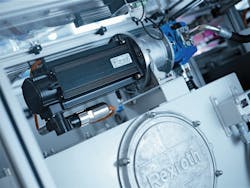Fixed-displacement pump delivers variable output
Hydraulic power units (HPUs) for industrial hydraulic systems often use variable-displacement pumps as a means of saving energy when machine cycles do not require full power. An alternative method could be to use a fixeddisplacement pump driven by a variable-speed electric motor. This did not prove practical in the past because inertia of the motor-pump would prevent the pump from being able to produce rapid changes in pump flow. Also, the higher cost and lower efficiency of the variable-speed drive tended to offset the potential energy savings. Newer technology, however, now makes a variable-speed electric drive powering a fixeddisplacement hydraulic pump a more energy-efficiency and quieter alternative for some applications.
At least four companies have introduced different versions of variable-speed pump drives in recent years:
• All World Machinery Supply, Harvard, Ill., offers a variety of power units, including those using an internal permanent magnet switched reluctance motor from Daikin, of Japan, that reportedly can reduce HPU power consumption by up to 95%.
• eCycle Inc., Temple, Pa., offerers made-to-order HPUs using fixed-displacement pumps powered by high-efficiency permanent magnet brushless DC motors. The design allows recovering energy when the pump is backdriven, converting the DC motor into an electric generator.
• Kadant AES, Queensbury, N. Y., provides its Unigy system, which uses a high-efficiency, Flux Vector Drive using sophisticated software that is said to achieve efficient, precise control without the need for electrohydraulic proportional and servovalves and feedback transducers.
• Bosch Rexroth Corp., Bethlehem, Pa., recently introduced two versions of its variable-speed pump drive, called DvP. Instead of using a conventional variable-displacement pump — where an asynchronous motor controls the displacement and pressure via internal control mechanisms — Bosch Rexroth relocated closed-loop control into a converter. During partial load operation — when little no hydraulic flow is required — the frequency converter reduces the speed of the electric drive and the fixed-displacement motor. Doing so reduces energy consumption, hydraulic power losses, and noise. As soon as the hydraulic system requires more power, the converter adjusts motor speed in line with demands.
Bosch Rexroth offers two different systems that combine its drive and control expertise in both hydraulics and electric drives. The first uses a high-dynamics servomotor to provide the required torque within very short acceleration times. Rexroth’s intelligent converter evaluates command values and actual values (provided by a pressure transducer), and adjusts motor speed accordingly. Software considers hydraulics-specific controller strategies and automatically compensates for non-linearities of hydraulics technology. This method results in dramatic energy savings and noise generation.
The second method uses a standard asynchronous motor to assume the drive function. Rexroth IndraDrive Fc converter controls the speed of the electric motor, and the control loop is closed using a pressure transducer. When operated continuously at low speed, this method requires an auxiliary cooling fan for the electric motor. Compared with the servomotor method, this solution features significantly lower acquisition costs.
Both methods fit seamlessly into decentralized and central control architectures of industrial machines. Depending on the specific concept, an OEM can integrate the converters from Rexroth into a control cabinet or mount them directly on the hydraulic power unit. Speed-related pump drives also cut lifecycle cost when retrofitted to existing machines.
Click here for more information on Bosch Rexroth’s Sytronix drives, or call (800) 739-7684.


